The Razor’s Edge: An Interview with Liam Sharp
Earth’s Mightiest’s own Brent Sprecher picks the brain of one of the UK’s greatest contributions to comic book art, Liam Sharp, in this exclusive interview!
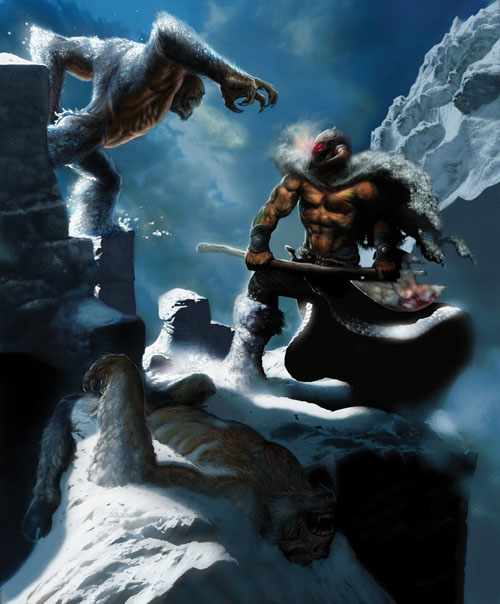 With his wife Christina, Liam started Mam Tor Publishing in 2004 and their Event Horizon anthology received the prestigious Sci-Fi-London award for Best Graphic Novel in 2006. Constantly growing, constantly evolving, Liam’s acclaimed work on Vertigo’s Testament has rightfully earned him a whole new generation of fans. Whether drawing, painting, writing or singing in his rock band, Liam’s the type of artist who strives to connect with his audience, to share with them the thoughts, feelings and inspirations that make the man behind the art.
With his wife Christina, Liam started Mam Tor Publishing in 2004 and their Event Horizon anthology received the prestigious Sci-Fi-London award for Best Graphic Novel in 2006. Constantly growing, constantly evolving, Liam’s acclaimed work on Vertigo’s Testament has rightfully earned him a whole new generation of fans. Whether drawing, painting, writing or singing in his rock band, Liam’s the type of artist who strives to connect with his audience, to share with them the thoughts, feelings and inspirations that make the man behind the art.
BRENT SPRECHER: Thank you for taking the time to answer a few questions for your fans, Liam.
LIAM SHARP: You're extremely welcome. I'm looking forward to it!
BS: In the past, apprenticing was a common, and often required, means of acquiring the skills and techniques of many different types of crafts and businesses, but it seems to be a dying practice. You got your start in comics working as an apprentice to Don Lawrence, artist of the Dutch comic book Storm. How did that come about and how did the experience prepare you for working as a comic book professional?
LS: Actually I don’t think anything can prepare you for the reality of working in comics! Well not the isolating aspects, and the required discipline you can only get with age – unless it’s inherent (which it wasn’t in me…) What that kind of apprenticeship can do, though, is forward your technique, and make you think in ways you otherwise wouldn’t.
Don was a friend of a friend of my godfather, and because I was into comics when this opportunity came up it seemed just perfect. To keep it brief Don liked my work, I did a few weeks try-out, and everything fell into place.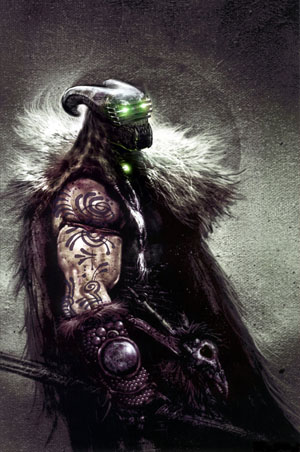
I loved Don, and learned a great deal from him - but it was a double-edged sword. The idea was for me to eventually take over Storm from Don, so for most of a year I simply copied his paintings stroke for stroke, until you could barely tell us apart. The trouble was I wasn’t Don, and at that time you had The Watchmen, Dark Knight, the final great issues of Heavy Metal magazine with guys like Corben and Serpieri, Sienkewicz’s Electra Assassin – all this amazing, boundary pushing stuff, and I wanted in on it! The notion of just being a clone was troubling, and I started to wonder what exactly my style was – and honestly, that ended up plaguing me for most of the next 20 years!
But Don did make me think about things in a whole new way – layouts, design, using your imagination fully and properly. He taught me to be more organic, and everything I know about texture in inks I learnt from him. He was a genius, really. It’s a shame the US never fully discovered his remarkable art.
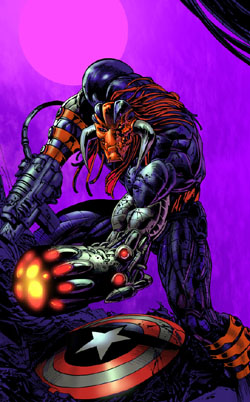 After me, Chris Weston was apprenticed to Don. It’s taken us both this long to feel he’s no longer watching over our shoulders giving us a tough time of it. He was a wonderful man, but a harsh taskmaster!
After me, Chris Weston was apprenticed to Don. It’s taken us both this long to feel he’s no longer watching over our shoulders giving us a tough time of it. He was a wonderful man, but a harsh taskmaster!
BS: Most American comic book fans are woefully uninformed about the incredible wealth of outstanding comic books and graphic novels being published outside of the United States. My own belief that I was a "comic-head" was challenged when a friend gave me a box of some 200-plus British comic books containing such strange and wonderful titles as Rogue Trooper, Nemesis the Warlock, Sam Slade: Robo-Hunter, Sláine and ABC Warriors. For me, that experience was like getting a glimpse at a parallel world. Growing up, were you aware of or have access to American comic books or were they as strange to you as British comics were to me?
LS: The thing about Britain is that it’s really mid Atlantic – not geographically of course, but culturally. We grew up with a little from both America and Europe. US comics were in every corner shop in those days. The Hulk and Wonder Woman were on TV, we all watched the Spiderman cartoon. My first memory of a comic was a Gene Colan Dare Devil issue featuring the Stiltman from 1967, a year older than me so it must have been an uncle’s copy or something. I loved superhero comics. Then we had the UK reprints, and when I was about 10 I started collecting the Star Wars comic, with these fantastic back-up stories – Adam Warlock, Starlord, Gods from Outer Space by Alex Nino, just amazing stuff! Also comics like Rampage featuring the Hulk, and there was an FF comic too.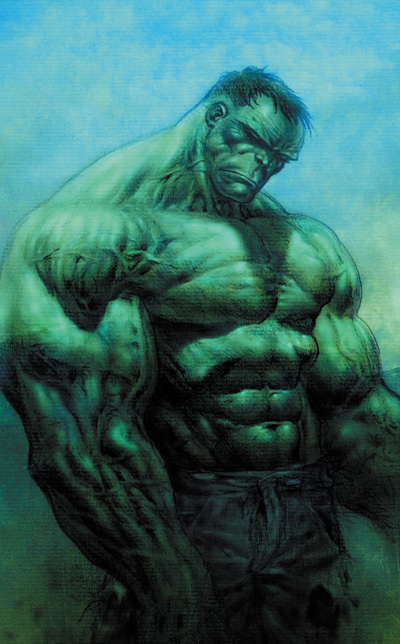
Around about that time the first 2000ad comics came out, and these featured some European artists, influenced – I would later learn – by people like Moebius, or more grown-up pulp mags like 1984. So you’d have Dave Gibbons and Brian Boland clearly taking their lead from classic US artists like Alex Raymond and Gil Kane. Then you’d have Mike McMahon and Ian Gibson looking more like Jesus Redondo – you’d also have genuine European artists in there, like Carlos Ezquerra. It was a great, pulpy mix. Wonderful stuff. By my late teens I was heavily into Heavy Metal magazine, which was really just a US version of Metal Hurlant from France. I loved all that crazy stuff – sexy and cerebral in equal measure back then. Work like Ranxerox by Liberatore just totally shocked and mesmerized me. And Roger Dean’s publishing company Paper Tiger/Dragon’s Dream were reprinting crazy stuff such as Lone Sloane: Delirious, and Yragael/Urm by Phillippe Druillet. It felt like a new dawn, until suddenly it all swung back to the US with the classics I mentioned earlier – Watchmen, Killing Joke, etc.
So, actually we had a really rich comic vein to plunder in the UK, but you had to look for it!
BS: What do you think distinguishes the British comic book in concept, sensibility and execution from its American counterpart?
LS: All of the stuff I just mentioned I think. Often it seems – and this is a gross generalization I know – that US comic readers are split into too camps: DC or Marvel readers. We had US comic readers, DC readers, Marvel readers, Marvel UK readers, European comic readers… it may simply be that we were exposed to more varied concepts of what comics could be. But honestly, the great stuff is out there. A lot of the US creators I’m friends with know of and sought out all the same stuff I did. The rest is just cultural!
But you do have more truly mainstream-rooted creators than us I think. Guys that really DID grow up reading only DC comics, and who know that universe backwards! We had to get what we could from the US, and you couldn’t count on sticking with a series – there was only whatever they had on the shelf, and that was usually pretty random. As a result a lot of UK artists I know just picked up the stuff they liked the look of, not because it was Batman, or Superman, or Ironfist – whatever. We didn’t get into the mythos, we got into the art. It wasn’t the iconography that sold us – not entirely at any rate.
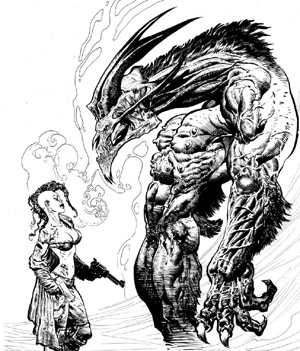 BS: Why do you suppose we haven't seen more British titles making the trip to comic shops in America?
BS: Why do you suppose we haven't seen more British titles making the trip to comic shops in America?
LS: Actually it may simply be there isn’t any more than what you already got! We have a tiny output over here – it’s shocking. There’s 2000ad, there’s the reprint and licensed stuff, and then you’re scratching your head a bit. We (Mam Tor) made a stab at it with Event Horizon, but that was distributed through Diamond US anyway. Markosia and a few other small publishers are trying. The UK is awful at supporting its creators, and that’s why we’re all working in the US!
The UK public is still fairly entrenched in some sort of general notion that it’s embarrassing to read comics – no matter how many TV and radio presenters say otherwise, or how many cultural magazines say comics are cool. There remains this dumb notion it’s a pursuit for geeks. We’ll dress like geeks if it’s cool to do that, but we don’t want to have to act like them! HA!
Strangely what you have in the US is a massive amount of comics created by us Brits – so in that sense you actually DO get the UK comics. It’s just that you produce them for us over there!
BS: So true! Most of my favorite comic writers and artists are Brits, come to think of it! Your big break in American comic books had a lot to do with the incredible makeover you gave to the anti-hero Death's Head in the Death's Head II mini-series for Marvel UK. Marvel recently attempted to revamp the character once again in The Death’s Head 3.0, but fans were generally unimpressed. If Marvel asked you to revisit Death’s Head, would you be interested in doing so or do you feel you’ve already explored the character to your satisfaction?
LS: Oh, I’d be all over it! Bryan Hitch and I pitched Marvel a Death’s Head reboot a little over a year ago. It got right to the top of the pile, but was passed on by marketing I heard – they didn’t think they could sell it. Maybe it was because the DH3 series stung them somewhat – I never read it, so I can’t comment on what I thought about it - but that’s just conjecture. I don’t have the facts.
For some sad reason Marvel UK books of that period have become a bit of a laughing stock or embarrassment. People seem to remember the fall rather than the heights, but DHII sold half a million copies (the most sales to be exported out of the UK ever!) and at the time was really brutal – especially for a mainstream comic! We were pretty bold back then. Sure, I loved and miss Death’s Head II. Man, they never even collected that mini series! It’s nuts! I reread it all recently and it still stands up. Great days.
BS: You’ve worked on most of the classic superhero characters— Batman, Superman, Spider-Man, Hulk, the X-Men—but have also tackled graphic, mature-themed titles like Jaguar God and Frank Frazetta's The Death Dealer. Do you prefer one genre to the other?
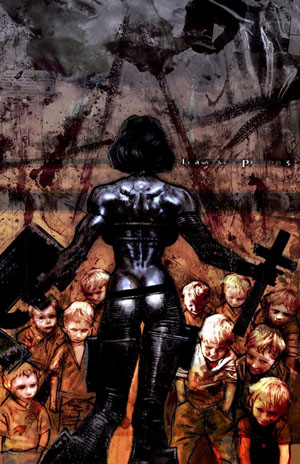 LS: No, not really. I love them all - but I’m a very restless creative. In my heart I want to be Bill Scienkewicz, Dave McKean, Moebius, Ash Wood, all those avante-garde trend-setters. But I also want to be a master like Frazetta, Corben, Barry Windsor-Smith, Kaluta, Jeff Jones. And also super-mainstream like Jim Lee, Hitch, Cassaday… Life’s short! I couldn’t bear spending it trapped in a barely fluctuating single version of myself! That’s why I also write and paint. I’m far more diverse, I think, than a lot of comic people realize – or like. I think that’s confusing to some readers.
LS: No, not really. I love them all - but I’m a very restless creative. In my heart I want to be Bill Scienkewicz, Dave McKean, Moebius, Ash Wood, all those avante-garde trend-setters. But I also want to be a master like Frazetta, Corben, Barry Windsor-Smith, Kaluta, Jeff Jones. And also super-mainstream like Jim Lee, Hitch, Cassaday… Life’s short! I couldn’t bear spending it trapped in a barely fluctuating single version of myself! That’s why I also write and paint. I’m far more diverse, I think, than a lot of comic people realize – or like. I think that’s confusing to some readers.
A lot of comics are really just big blustery soap operas; nobody dies forever, and the more consistent and uniform it is the better – and you’d also better not mess with it in any way! For whatever reason I’m not like that at all. I like diversity and change and challenge. I want to be creative. I’m a classic non-conformist – but I can’t understand why anybody would WANT to conform! To me that stinks of smugness, like we’ve reached this state of nirvana that mustn’t ever change. It’s so unimaginative, and shortsighted! Like it or not, change is always coming and there’s nothing anybody can do to stop it!
BS: Most recently, you worked on the DC/Vertigo comic Testament with Douglas Rushkoff and the Countdown-related book, Lord Havok and The Extremists, with Frank Tieri, two wildly different projects. Artistically, is it hard to “switch gears” from project to project? Do you have to prepare yourself differently in any discernible way?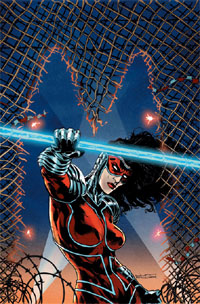
LS: I find it no effort at all – actually it’s a relief when I get to diversify! I always have other stuff going on. You can either take it all too seriously or not seriously enough, so it’s good to have different perspectives – to be able to view the whole spectrum. Nothing is more fun than being asked to do something you’ve either never done before, or not done for a very long time. Lord Havok was a complete throwback to my early 90’s heyday, and I loved it. Testament was the kind of intelligent, thought-provoking series for Vertigo I’ve wanted to do my whole career. It can’t be more satisfying than that I don’t think – except for writing myself, which is something I don’t get to do nearly enough of! Actually that’s my biggest frustration, as I’m a compulsive writer. I write all the time, and in many ways enjoy it more than drawing. But hey, there’s still time!
BS: Creatively, is there more or less freedom working outside of the mainstream, superhero genre?
LS: Surprisingly not. Vertigo were the most editorially hands on department I’ve ever worked for. Conversely I was pretty much left alone on Lord Havok – except for when it came to the specifics of the tie-in with Countdown. You have to give the editors what they want, and to be able to adapt to the way they run their books – ultimately it’s their show, and prima dona posturing will only get you what you want if you’re selling huge numbers, and it certainly won’t make you any friends! We’re freelance artists. They’re not our books. So we have to adapt.
Of course what I really want to do is write and draw my own stuff with no restrictions at all, but very few of us get that privilege – unless we find the time and take the risk ourselves by self-publishing.
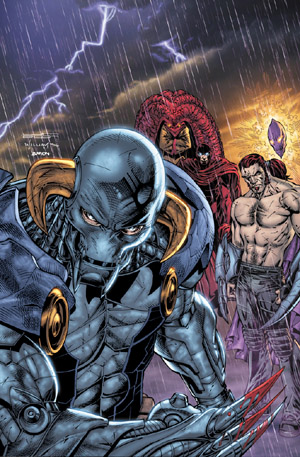 BS: Unfortunately, we often form initial opinions about others based solely upon superficial information, such as haircut or clothing style. Do you feel that people draw conclusions about you based upon the content or style of your artwork?
BS: Unfortunately, we often form initial opinions about others based solely upon superficial information, such as haircut or clothing style. Do you feel that people draw conclusions about you based upon the content or style of your artwork?
LS: Oh, totally – and by how I’ve looked! I’ve heard rumours that I’m a drug addled alcoholic that can’t hold a deadline down! I’ve also heard that people thought I was this moody tattooed beast! HA! People are sometimes surprised I’m only six foot two because they have this perception I’m some kind of giant – based on what exactly I don’t know! Anybody who knows me well finds all this stuff hilarious! I’m a total pacifist. I’m a liberal armchair philosopher. I love anthropology, the origins of myth in history. I’m fascinated by string and membrane theory and love documentaries on science and art. More than anything I’m somebody interested in culture – so it may seem odd that I’ve drawn nihilistic stuff like GOTH and the Death Dealer for Verotik.
I guess it comes down to the non-conformist in me. Just because I can acknowledge the baser aspects of myself, and can play out thuggish wish-fulfillment macho fantasies in my comic work (either a product of being an unhappy, bullied child for a while, or some sort of Jungian symbolic need for fascistic uncomplicated heroes at the core of the male psyche – I haven’t decided which yet, but it’s probably a bit of both!) doesn’t mean I don’t also have the capacity to enjoy the sublime metaphysical dream-channeling work of Moebius! I love a bit of Metal, I adore classic rock and a fair bit of prog rock, but I also like Rufus Wainwright and Jeff Buckley. I like folk, classical music, ska, even a bit of punk and pop. It’s good to keep your eyes open I think.
There’s this horrible – in my opinion – need in society these days to pick you side and stick with it; to create lists of favorite things that somehow define us. To fix ourselves rigidly as inflexible entities, and not be prepared to consider other possibilities. I’m constantly having my mind changed by other better arguments. I don’t have a favorite band, color, TV show, Month, Day, place, brand, football team… it’s all stuff that just serves to keep us in tribes, not embracing diversity. So yes, I think a great many people get me wrong!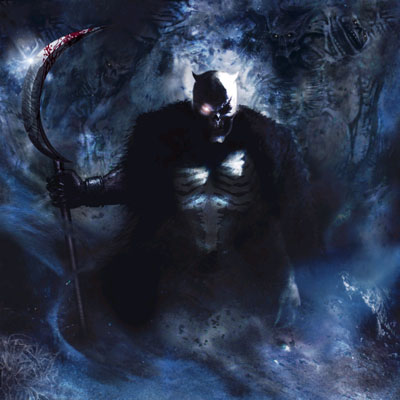
BS: You regularly update your Deviant Art (DA) journal and are often quite candid. What I continually find inspirational about your journals is how willing you are to just lay it all out there. As an aspiring artist, it helps me to know that even accomplished professionals such as yourself are sometimes plagued by feelings of frustration and self-doubt. Does writing the journal help you to break through those darker moments?
LS: Thank you, I appreciate that. I’m often conflicted, actually, when it comes to my journals. In the past I’ve been advised to be prudent about what I say, and to only present the positive. But then I think that’s not the truth of the business! I’m not a dirt-disher, and I won’t say anything shitty about my fellow creatives on a public forum or blog, no matter what I might thing privately. But I WILL be candid, and I WILL tell you what it’s like, and what you have to expect. There are so many things I wish I knew going in that I know now. Things I never considered! My journals are often aimed at helping new creatives navigate the freelance landscape.
I’ve also been inspired to keep going with them because of the wonderful feedback I get. I feel it’s an important part of my audience, and that the people who read my blogs and journals are kind of pilgrims – we’re all on the same road. Often it’s just good to be able to present the other aspects of myself, and my work, even if relatively it’s a tiny audience. These days I get more people coming to look at my new journal entries than I do if I post some new art! This tells me it’s valid and worth pursuing – and sure, it also helps me find clarity. My dark moments are fewer and further between now because I don’t beat myself up as much!
 The journal is also a great place to share some theories about the origins of comic art, and it’s place in society. I’ve been writing this stuff for a few years now, and more and more I keep hearing it filtering back to me. I wrote a massive blog about whether comic art was art, and the origins of heroic storytelling – which I’ve edited several times and expanded upon and reposted – and I heard Jon Favreau pretty much spouting the same theory verbatim on the radio the other day with regard to Iron Man. Whether or not it came from my blog – he’s a MySpace friend – I don’t know, but either it did, or there’s a zeitgeist thing going on where people are starting to think the same thing. If that’s the case, then it potentially bodes well for the acceptance of comics and other subculture genres in the public at large.
The journal is also a great place to share some theories about the origins of comic art, and it’s place in society. I’ve been writing this stuff for a few years now, and more and more I keep hearing it filtering back to me. I wrote a massive blog about whether comic art was art, and the origins of heroic storytelling – which I’ve edited several times and expanded upon and reposted – and I heard Jon Favreau pretty much spouting the same theory verbatim on the radio the other day with regard to Iron Man. Whether or not it came from my blog – he’s a MySpace friend – I don’t know, but either it did, or there’s a zeitgeist thing going on where people are starting to think the same thing. If that’s the case, then it potentially bodes well for the acceptance of comics and other subculture genres in the public at large.
BS: For those who may have missed your DA journals, could you briefly explain what “Free Your Dragons” means to you and how it relates to art?
LS: The “Free Your Dragons” post was perhaps the journal entry that turned everything around for me as it got so many replies and responses, kind words and shared feelings. It more than any other made me feel they were worth doing.
I’ve been very lucky in my career to have been able to try so many different things out – as you say, from the mainstream to the culty adult sub-cultural stuff. I’ve been able to try on the stylistic and genre mantles of all my artistic heroes to see how well they fit – and yet at the time I hadn’t realized I was doing that. The nub of the journal is that it wasn’t until I looked back on almost 20 years of career that I was able to appreciate exactly what I had achieved. It wasn’t fame, or fortune (things I thought I wanted, and didn’t really achieve, having foolishly judged myself against the false perception of commercial success) but something far more wonderful – I had doggedly pursued my dreams and fulfilled them without even realizing it. So I’d freed all my creative dragons. The trick, though, was taking the time to look back and watch them fly.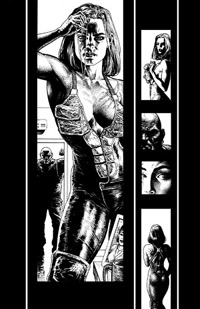
BS: In one of your latest DA journals, you referred to comic books and comic book art as a “mongrel under-dog subculture artform” and posited the controversial question, “Is comic art real art?” As a comic book professional, have you had to defend your vocation to those unfamiliar with or disappoving of the modern comic book?
LS: Yeah, that’s the one I was referring to earlier on – the origins of heroic storytelling and so on. What I found that shocked me was that in one period when I couldn’t get any comic work for a couple of years I was amazed to find that illustration agencies wouldn’t touch me because of my association with comics! Comic artists have in my experience the toughest, least regarded, poorest paid most isolating and labor-intensive art-related job you can get. We have, without question, to be able to draw ANYTHING. Literally. We have to draw multiple panel artworks that may feature a cast of thousands, research of historic locations and architecture. We have to be anatomists, architects, fantasists and fabulists, cartoonists, portraitists, set-designers, lighting technicians, choreographers, directors, cameramen, draughtsmen… and we have to do it quickly.
So, when I was getting these rejections I was quite rightly furious and utterly disarmed and helpless. I wanted to know why! That, I think, really got me on the path of questioning what art was – what it was that the other realms of the art-world didn’t like about comics. Was it historic, or subjective? When, in history, had this moment arrived? And, yes: Why? The answers I started to come up with were pretty fascinating!
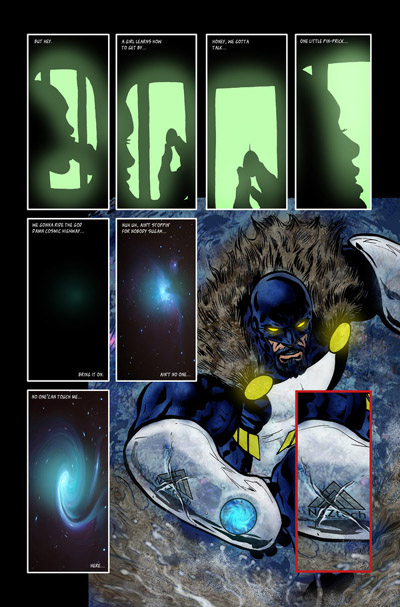 Ultimately I’m left seriously doubting the existence of REAL art, and think instead that what we have is yet more tribes with their closed minds and inner sanctums. Each circle protecting and reinforcing it’s own status, bulwarked primarily by how rich and influential, ancient and revered it might be.
Ultimately I’m left seriously doubting the existence of REAL art, and think instead that what we have is yet more tribes with their closed minds and inner sanctums. Each circle protecting and reinforcing it’s own status, bulwarked primarily by how rich and influential, ancient and revered it might be.
Culturally, we only started to damn the heroic saga in the west a little over a hundred years ago. Before then it had a noble heritage, from Gilgamesh through the Odyssey and Aeneid to Beowulf and La Morte D’Arthur. The pompous put-down of imaginary fiction and art is a very recent thing!
BS: You initially formed Mam Tor Publishing with your wife, Christina, to produce a portfolio piece, but it has evolved considerably since then. The graphic novel series Mam Tor: Event Horizon won the 2006 Sci-Fi London award for Best Graphic Novel and received other accolades. What is going on at Mam Tor right now and what are your hopes for its future?
LS: Mam Tor continues to diversify. We just did a collaboration with a top advertising agency called Mother, which resulted in the production of 200,000 inserted free comics in Time Out (London) Magazine - great for taking the medium to a new audience. That’s now a quarterly thing, with three more coming out this year. We’re going to be doing a Chris Weston artbook, which will be stunning. We’ve also produced two novels, and are planning more, and produced Matt Coyles gothic-noir masterpiece Worry Doll. Some of the finest drawing I’ve seen, period, and even his text has been compared to Samuel Beckett.
BS: What is JUNX?
LS: JUNX started life with ComX, then went to Wildstorm, then left Wildstorm, and now it’s possibly back there as a proposed co-venture. We’ll see. It’s an epic script for a 12 part story that I hoped another artist would draw because I didn’t initially think I had the chops to do it justice myself – nuts though that may sound!
Ten years on I just thought [frick] it, I should do this book – it’s good! So I rethought the approach, kind of did a retro refit, thinking about it more in terms of work like Miller’s classic Ronin, where the epic nature of the story was more important than the detail in the art. It’s kind of a labor of love I guess. So we’ll see if they bite! If not I’m pretty sure Mam Tor will go ahead and put it out down the line – of course I’ve still got another sixty pages to draw first though…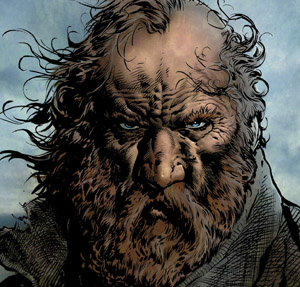
BS: Do you have any other upcoming projects or events you want to mention?
LS: Sadly nothing I’m allowed to talk about! But I’ll be at the Wizard World Philly show if anybody wants to come and drop by. I have a table in artist’s alley.
BS: You said that this line from a novel by M. John Harrison summed up the last twenty years of your life:
"People lose their way as an act of defense. Then they panic and decide they have to find it again."
What line would sum up your hopes for the next twenty years of your life?
LS: HA! I think that might have to be another M. John Harrison quote from the same book:
“You want to know what it’s like in there? The fact is, you spend all those years trying to make something of it. Then guess what, it starts making something of you.”
BS: Thank you so much for your time, Liam!
LS: Absolutely my pleasure. Take care.
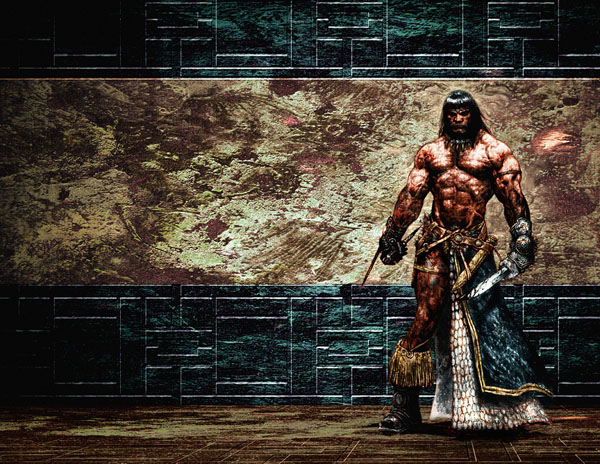
Click HERE for Mam Tor Publishing
Click HERE for Liam Sharp’s DeviantArt Page
Click HERE for Liam Sharp’s MySpace Page
Check out all of Brent Sprecher’s exclusive interviews with today’s hottest comic book professionals!
Click HERE for an exclusive interview with Secret Invasion artist Leinil Yu!
Click HERE for an exclusive interview with Wolverine artist Marcelo Frusin!
Click HERE for an exclusive interview with Hero By Night creator DJ Coffman!
Click HERE for an exclusive interview with Jaded Publishing’s Andrew Chung!
Click HERE to watch an exclusive interview with award-winning writer Grant Morrison!
Click HERE for an exclusive interview about Bluewater Productions’ latest comic adventure, Spaced Out!
DISCLAIMER: This posting was submitted by a user of the site not from Earth's Mightiest editorial staff. All users have acknowledged and agreed that the submission of their content is in compliance with our Terms of Use. For removal of copyrighted material, please contact us HERE.